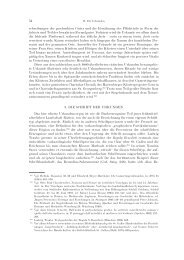Chapter Three ANTHOLOGIES AND ANTHOLOGISTS Between c ...
Chapter Three ANTHOLOGIES AND ANTHOLOGISTS Between c ...
Chapter Three ANTHOLOGIES AND ANTHOLOGISTS Between c ...
Create successful ePaper yourself
Turn your PDF publications into a flip-book with our unique Google optimized e-Paper software.
112<br />
Part One: Texts and Contexts<br />
gr. 433 (s. XI) 91 . What is more, Ignatios the Deacon did not hit upon the<br />
unusual idea of writing a sepulchral eis heauton (AP XV, 29) all by himself, but<br />
probably adopted the idea from Gregory of Nazianzos (cf. AP VIII, 80–84 and<br />
Greg. Naz. II, 1, 99). In AP XV, 29 Ignatios speaks to us from the grave,<br />
confesses his sins and prays to God for mercy 92 . AP XV, 30 and 31 are ordinary<br />
encomiastic epitaphs: the first praises a young man called Paul for the virtue<br />
and intellectual brilliance he displayed when he was still among the living; the<br />
second celebrates Samuel, a deacon of the Hagia Sophia, who showed his<br />
Christian zeal and piety by bequeathing his earthly possessions to the church.<br />
The language and style of these three epitaphs is obviously classicizing, but it<br />
is impossible to identify a particular literary model imitated by Ignatios: we<br />
find Homeric endings, such as -oio, -øsi and -essi, but Byzantine elegiacs in<br />
general make use of Homeric forms; Ámmati eJmen6i may be an imitation of Ámma<br />
eJmen6ß in AP VIII, 248. 2 by Gregory of Nazianzos, but late antique and<br />
Byzantine poetry is fond of the word Ámma (“the eye of Justice, the Emperor,<br />
God Almighty”, etc.) 93 ; parallels for the rare expression n lagönessi aÉhß (“in<br />
the womb of earth”) can be found in ancient inscriptions 94 , but was Ignatios<br />
familiar with these parallels? Ignatios does not make prosodic errors, but<br />
rather surprisingly treats the caesura of the pentameter as a full stop where<br />
hiatus and even brevis in longo are allowed (29. 6; 30. 2 (!); 30. 4; 31. 2). The two<br />
book epigrams AP XV, 39, v. 1 and vv. 2–3 clearly indicate that Ignatios the<br />
Deacon did some scholarly work on Homer: see their title: “on the same”, that<br />
is, on Homer (the subject of AP XV, 36–38), and see the phrase soó‰ß pol7idriß<br />
äoid‰ß 95 . Ignatios proudly states that he “has brought to light the science of<br />
grammar hidden in the ocean of oblivion” – which is probably a gross exaggeration,<br />
but at least gives a clue as to Ignatios’ precise contribution to the field<br />
of Homeric scholarship: grammatical epimerisms on Homer 96 . Since Homeric<br />
91 See H.M. WERHAHN, Übersichtstabellen zur handschriftlichen Überlieferung der Gedichte<br />
Gregors von Nazianz, in: W. HÖLLGER, Die handschriftliche Überlieferung der Gedichte<br />
Gregors von Nazianz. 1. Die Gedichtgruppen XX und XI. Paderborn 1989, 34.<br />
92 The last two verses were re-used by the scribe of Laur. LXX 20 (s. XI) as a token of his<br />
humility: ed. B<strong>AND</strong>INI 1763–70: II, 680 and COUGNY 1890: IV, no. 116. The epigram can<br />
also be found in Laur. XXXII 16 (see below, n. 119) and in Barb. gr. 74, Allatius’<br />
collection of Byzantine poems (the source used by Allatius is the Palatine manuscript<br />
itself, which was in Rome at the time).<br />
93 See, for instance, ROBERT 1948: 17, 25 and 138.<br />
94 See CIG 7. 117 and 14. 2001.<br />
95 In Ignatios’ letters no pagan author is quoted as often as Homer: see the Fontes in MANGO<br />
1997.<br />
96 On ninth-century Homeric epimerisms (by Choiroboskos?), see A.R. DYCK, Epimerismi<br />
Homerici. Pars prior epimerismos continens qui ad Iliadis librum A pertinent. Berlin–<br />
New York 1983, 5–7; Pars altera epimerismos continens qui ordine alphabetico traditi<br />
sunt. Berlin–New York 1995, 23–24.




